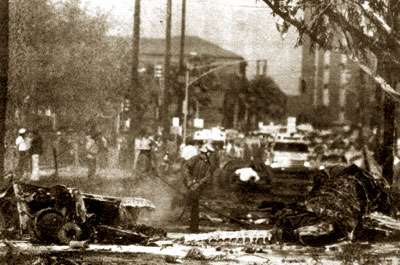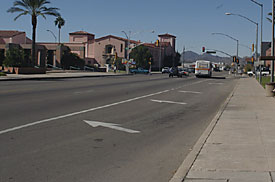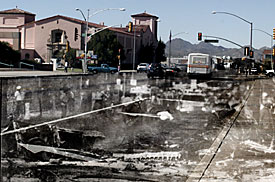 |
|
File photo/Arizona Daily Wildcat
|
Today traffic marks the intersection at East Sixth Street and North
Highland Avenue. But it was a different picture 25 years ago on Oct.
26, 1978, after a military plane crashed near the site of the present
day Recreation Center, killing two students. The photo above
depicts the crash scene in 1978. The photo below shows the
intersection today. The bottom photo is a composite of both photos.
|
|

Claire C. Laurence/Arizona Daily Wildcat
|
|

Composite photo by Will Seberger and Claire C. Laurence
|
|
It was 74 degrees on Oct. 26, 1978. It seemed like the perfect day to be outside.
Anne Padias, who was a post-doctoral chemistry associate at the time, went outside to eat her lunch on one of the Mall's sprawling lawns.
As she enjoyed her lunch, she noticed something flying low overhead.
It wasn't uncommon for military jets to fly low as they crossed over the campus on their approach to Davis Monthan Air Force Base, but this jet was flying too low, said Padias, who is now an assistant chemist at the UA.
"There was this loud pop," Padias said. "It was the pilot getting ejected and then a boom."
Twenty-five years ago Sunday, a U.S. Air Force jet crashed into the intersection of East Sixth Street and North Highland Avenue, killing two students and injuring six others.
This was the second time a military jet crashed in Tucson. In 1967, an air force jet crashed into a supermarket in southeast Tucson, killing four people.
The 1978 crash, which put a crater in the middle of Sixth, has been imprinted on the memory of those who witnessed the tragedy. Twenty-five years later, they still can't shake off the fear they feel when a jet flies above.
"Now every time a plane flies over it makes you wonder, said Padias. "You don't have this faith they'll stay up there."
Davis Monthan would not return phone calls.
Loud military jet engines disruptive
U.S. Air Force Capt. Fredrick L. Ashler was en route to Davis Monthan that day in an A-7D Corsair Jet from Tinker Air Force Base, Okla., according to an article which appeared in the Arizona Daily Star the following day.
A compression failure in the jet's engines caused it to lose power. As the jet descended on the UA campus, Ashler tried to aim it towards a football practice field on the corner of Sixth and Highland, where the Student Recreation Center now stands.
Although Ashler missed his landing target, he was able to clear the campus and miss Mansfeld Middle School, which is also on the corner of Sixth and Highland.
Though two Mansfeld students suffered minor injuries, the damage could have been much worse.
Many thought Ashler should have been awarded for diverting the plane from both of the school campuses.
Tom Volgy, who witnessed the crash, called the pilot a hero for doing all he could to keep the jet under control, and for risking his own life to direct it away from the middle school.
"You just don't do that unless you're willing to sacrifice your life for others," said Volgy, a political science professor.
Immediately after the crash, Davis Monthan reduced the number of planes flying over the UA by 50 percent, Volgy said.
In 1978, Davis Monthan had 65 planes taking off from the base every hour, all of which went over the campus.
But for some the 50 percent reduction wasn't enough.
The Arizona Daily Wildcat reported in 1978 that the Arizona Board of Regents tried to stop planes from flying over the campus at all.
Volgy, who was also a city councilman in 1978, said that after witnessing the crash, he went immediately to Morris K. Udall's office, who was serving as a democratic congressman.
Volgy demanded that flight paths over the school be changed.
A year and a half later, Volgy said Udall received enough appropriation from the U.S. Congress to reduce flights over campus by 90 percent.
Though air force planes continue to fly over the campus today, Volgy said the reduction has been adequate enough that the safety concerns at the UA in the '70s are not the same anymore.
"Davis Monthan is a billion-dollar impact on Tucson. I think we have resolved the safety issues," Volgy said.
Before the crash, Volgy said he used to have to stop teaching every five to 10 minutes as planes flew over campus.
While security and the noise level have improved since 1978, things aren't
perfect.
"In one my classes in Modern Languages this semester the window was open and the teacher had to actually stop class because a plane flew over," said Carla Demore, secondary education sophomore.
Jessica Smith, a communication senior, said that the noise from the planes sometimes disrupts the classroom.
"It has been hard to hear teachers in Education and the Social Science buildings," she said.
Ruth Dickstein, a librarian in the main library, said she remembered hearing a huge boom while she was in the reference room 25 years ago.
"People were really nervous after that when planes went over campus," Diskstein said. "I still get nervous when I see planesflying low."
Keeping the memory of crash victims alive
"He told me that there had been an accident," Marci Felix Harrington said. "I got this awful feeling."
Harrington, who was living in Montana at the time, will never forget the phone call she received the night of Oct. 26, 1978.
Harrington, older sister to the two victims, received the call from her uncle in Cananea, Sonora, a small mining town about 150 miles south of Tucson, where Harrington and her siblings were raised.
Harrington, who now lives in Tucson, was unable to get a flight to Tucson until the following morning and spent the rest of the night agonizing over the possible details of the accident.
"You just sense when something horrible has happened," she said.
When Harrington arrived at the Tucson airport, she was met by family members who told her both of her sisters had died.
Leticia Felix Humphrey, 21, a business education sophomore, and her sister, Clarissa Felix, 20, an early education junior, were driving down Highland in Leticia's blue Vega when the plane skidded down the avenue, hitting the car and engulfing it in flames.
 | |
It's just a matter of time until something like this happens again
- Marci Felix Harrington victims' sister
|  |
Humphrey was unable to escape from the burning car and died at the scene. Felix, who suffered third-degree burns over 90 percent of her body, died shortly after that at the University Hospital, now known as the UMC.
Dental records had to be used to determine who was who, both bodies were burned beyond recognition.
"My mom fell apart," Harrington said.
The UA never set up a memorial for Harrington's sisters, something Harrington said she wants to change because she wants to keep the memory of them alive.
"I hope that this never gets forgotten," Harrington said. "It was such a significant event."
Ever since the crash Harrington said she has hoped planes would stop flying over the UA.
"I'm sure there are other approaches to the base that planes can make," Harrington said. "It's just a matter of time until something like this happens again."
Something to say? Discuss this on WildChat
Or write a Letter to the Editor
|
